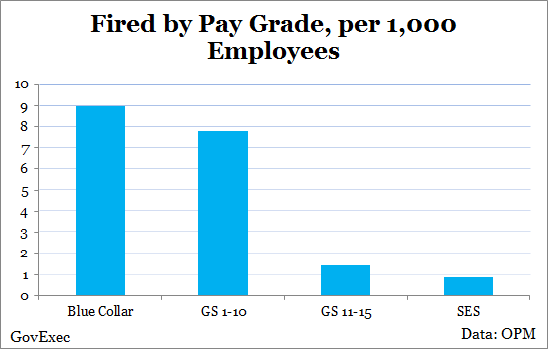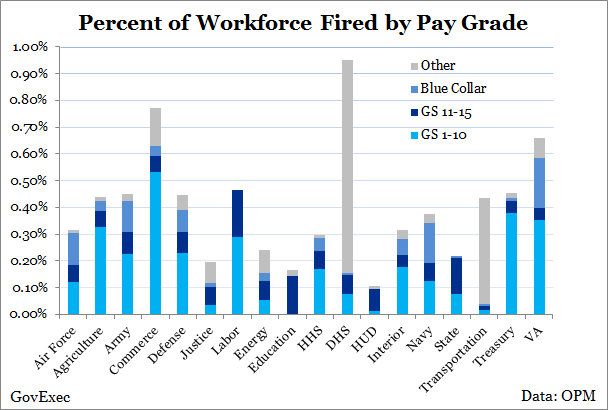
iluistrator/Shutterstock.com
Lower-Ranking Feds Are Nine Times More Likely to Be Fired Than Senior Execs
HUD, Education and State fire the fewest employees.
Lower grade federal employees are fired at a significantly higher rate than their managers, according to a Government Executive analysis of federal data.
General Schedule 1-10 employees are more than five times more likely than their GS managers to be fired for performance or discipline, and nearly nine times more likely to be let go than senior executives. Employees in positions designated as “blue collar” are more than 10 times as likely as Senior Executive Service workers to be fired.
Here’s a chart illustrating how many employees are fired in each pay grade, per 1,000 employees in each grade:

This chart shows significantly more GS 1-10s were fired at Cabinet-level agencies in fiscal 2013 than GS 11-15s, despite there being more employees in the GS 11-15 category than the GS 1-10. The “other” category on the chart represents employees who are in pay systems outside the General Schedule, such as Transportation Security Administration screeners. The SES category rounds down to zero from 8 hundredths of 1 percent.
.png)
Todd Wells, executive director of the Federal Managers Association, defended the practice of dismissing lower grade employees at a higher rate.
“The lower GS levels are often unskilled, lower paying positions that are more likely to attract people who may have never worked before, or who have had less work experience and education,” Wells told Government Executive . “The lower level jobs may or may not appeal to them as a career.”
Managers, Wells argued, generally have a proven track record, noting 91 percent of SES employees are career workers who have spent years climbing the federal ladder.
“If someone has risen through the ranks,” he said, “either within or outside government, to become a supervisor or manager, then he has proven himself over many years and generally has a greater understanding of the big picture and will therefore be more likely to be invested in his job.”
Firing statistics vary by agency, however.
Agencies that fire the smallest percentage of their workforces -- such as the Education, Housing and Urban Development, and State departments-- are actually more likely to fire managers than rank-and-file employees.
Education dismissed the fewest total employees in fiscal 2013 -- just seven -- while HUD fired the just one-tenth of one percent, the lowest ratio of any Cabinet-level agency.
The agency most likely to fire employees in fiscal 2013 was the Homeland Security Department -- dismissing about 1 percent of its workers last year -- followed by the Commerce and Veterans Affairs departments. Here’s a chart showing each agency’s firing rate, broken down by pay grade.

The debate over the ease with which federal agencies can fire their employees resurfaced in recent weeks, after the VA wait time scandal prompted lawmakers to consider several measures that would expedite terminations of VA senior executives.
Currently, senior executives must receive 30 days’ notice of a pending termination, a chance to review the charges and evidence against them, and an opportunity to offer a defense. VA fired more total employees than any Cabinet-level agency last year (though a lower percentage of its workforce than DHS or Commerce), but only two of them were senior executives.
( Top image via iluistrator / Shutterstock.com )
NEXT STORY: John Kerry Busted Taking a Brief Nap in Poland







